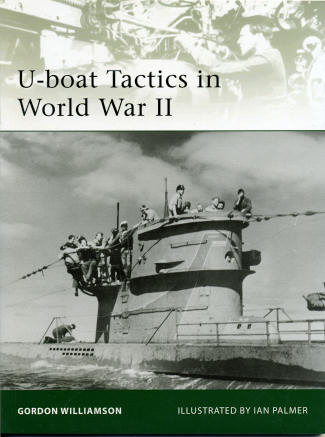 New
in Osprey's 'Elite' series is this one on U-boat Tactics during the Second World
War. Like all methods of waging war, the German U-boat fleet had to constantly
revise how it did business. At first, there was not much in the way of
opposition to the German submarine fleet. Of course, the Germans also didn't
have a whole lot of boats. The convoy system was something far off and so the
Germans basically started where they had left off in WWI.
New
in Osprey's 'Elite' series is this one on U-boat Tactics during the Second World
War. Like all methods of waging war, the German U-boat fleet had to constantly
revise how it did business. At first, there was not much in the way of
opposition to the German submarine fleet. Of course, the Germans also didn't
have a whole lot of boats. The convoy system was something far off and so the
Germans basically started where they had left off in WWI.
Submarines of the time were not only quite slow when
submerged, but they had very limited battery power. They also had limited
numbers of torpedoes. For this reason, many of the successful U-boat captains
preferred to do most of their attacking on the surface and to use the deck gun.
When coming up against a single ship. This was pretty much the way to go. They
first had the ship stop and if determined to be involved in carrying war
material or being one of the enemy's ships, the crew was allowed to abandon ship
prior to the submarine sinking it with their deck gun. The now ship-less crew
was often towed to the shipping lanes where they could be saved, or left with
dry clothes and survival rations.
Even later in the war, when convoys became more the norm,
submarine captains frequently snuck into the midst of the convoy on the surface
and started sinking ships. One ship; one torpedo was the motto of many and some
ship captains were able to do just that. However, as the war progressed and the
Allies developed more potent anti-submarine warfare gear, the U-boats had to
switch their tactics. No longer was the lone U-boat the way to go. Packs or
groups of submarines were sent out to stalk and ambush a convoy; sometimes with
fewer than half the ships actually making it to their destination.
German submarines had to come up with decoys and ways to stay
under water longer. However, despite technological advances, they rarely lasted
long and something else had to be developed.
In his book, author Gordon Williamson has a look at how
submarines operated at various stages of the war. There are sections on
associated equipment, offensive and defensive weapons/equipment, and various
defensive tactics used. This latter was more and more important as the war went
against the German submarine fleet. All of this is illustrated by a goodly selection of period
photographs and that artwork of Ian Palmer, who shows some very well done charts
of how both the submarines and Allied shipping dealt with the submarine war. It
makes for a book I found quite
engrossing and one that I can easily recommend to you.
November 2010
For more on the complete line of Osprey books,
visit www.ospreypublishing.com. In the US, it is
Osprey Direct at 44-02 23rd St, Suite 219, Long Island City, NY 11101., where you can
get a catalogue of available books.
If you would like your product reviewed fairly and quickly, please contact
me or see other details in the Note to
Contributors.
 New
in Osprey's 'Elite' series is this one on U-boat Tactics during the Second World
War. Like all methods of waging war, the German U-boat fleet had to constantly
revise how it did business. At first, there was not much in the way of
opposition to the German submarine fleet. Of course, the Germans also didn't
have a whole lot of boats. The convoy system was something far off and so the
Germans basically started where they had left off in WWI.
New
in Osprey's 'Elite' series is this one on U-boat Tactics during the Second World
War. Like all methods of waging war, the German U-boat fleet had to constantly
revise how it did business. At first, there was not much in the way of
opposition to the German submarine fleet. Of course, the Germans also didn't
have a whole lot of boats. The convoy system was something far off and so the
Germans basically started where they had left off in WWI.